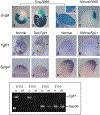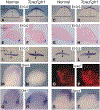Conditional inactivation of Fgfr1 in mouse defines its role in limb bud establishment, outgrowth and digit patterning
- PMID: 16120640
- PMCID: PMC6986394
- DOI: 10.1242/dev.02001
Conditional inactivation of Fgfr1 in mouse defines its role in limb bud establishment, outgrowth and digit patterning
Abstract
Previous studies have implicated fibroblast growth factor receptor 1 (FGFR1) in limb development. However, the precise nature and complexity of its role have not been defined. Here, we dissect Fgfr1 function in mouse limb by conditional inactivation of Fgfr1 using two different Cre recombinase-expressing lines. Use of the T (brachyury)-cre line led to Fgfr1 inactivation in all limb bud mesenchyme (LBM) cells during limb initiation. This mutant reveals FGFR1 function in two phases of limb development. In a nascent limb bud, FGFR1 promotes the length of the proximodistal (PD) axis while restricting the dimensions of the other two axes. It also serves an unexpected role in limiting LBM cell number in this early phase. Later on during limb outgrowth, FGFR1 is essential for the expansion of skeletal precursor population by maintaining cell survival. Use of mice carrying the sonic hedgehog(cre) (Shh(cre)) allele led to Fgfr1 inactivation in posterior LBM cells. This mutant allows us to test the role of Fgfr1 in gene expression regulation without disturbing limb bud growth. Our data show that during autopod patterning, FGFR1 influences digit number and identity, probably through cell-autonomous regulation of Shh expression. Our study of these two Fgfr1 conditional mutants has elucidated the multiple roles of FGFR1 in limb bud establishment, growth and patterning.
Figures








References
-
- Ahn S and Joyner AL (2004). Dynamic changes in the response of cells to positive hedgehog signaling during mouse limb patterning. Cell 118, 505–516. - PubMed
-
- Boulet AM, Moon AM, Arenkiel BR and Capecchi MR (2004). The roles of Fgf4 and Fgf8 in limb bud initiation and outgrowth. Dev. Biol 273, 361–372. - PubMed
-
- Charite J, McFadden DG and Olson EN (2000). The bHLH transcription factor dHAND controls Sonic hedgehog expression and establishment of the zone of polarizing activity during limb development. Development 127, 2461–2470. - PubMed
-
- Chiang C, Litingtung Y, Harris MP, Simandl BK, Li Y, Beachy PA and Fallon JF (2001). Manifestation of the limb prepattern: limb development in the absence of sonic hedgehog function. Dev. Biol 236, 421–435. - PubMed
-
- Ciruna B and Rossant J (2001). FGF signaling regulates mesoderm cell fate specification and morphogenetic movement at the primitive streak. Dev. Cell 1, 37–49. - PubMed
Publication types
MeSH terms
Substances
Grants and funding
LinkOut - more resources
Full Text Sources
Molecular Biology Databases
Miscellaneous

